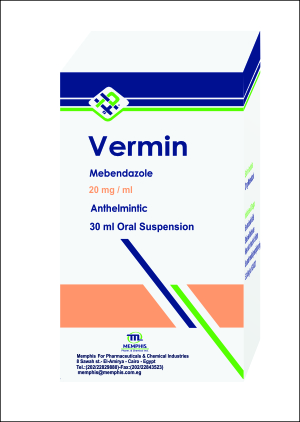TRADE NAME: VERMIN SUSPENSION GENERIC NAME: Mebendazole COMPOSITION: Each 1 ml contains : Active ingredient: Mebendazole 20 mg : Excipients Polyvinyl pyrrolidone ( PVP K 17),Microcrystalline celluose Type Rc 591 (Avicel Rc 591), Carboxy methyl cellulose sodium MV, Methyl paraben sodium, Propyl paraben sodium, Sodium lauryl sulphate, Sodium dihydrogen phosphate, Glycerin, Saccharin sodium, purified water. PHARMACEUTICAL FORM: Suspension. PHARMACOLOGICAL ACTION: PHARMACODYNAMICS: Pharmacotherapeutic classification: Anthelmintic for oral administration, benzimidazole derivatives. Vermin is a broad spectrum anthelmintic. Vermin interferes with the cellular tubulin formation in the worm thus disturbing the glucose uptake and the normal digestive functions of the worm to such an extent that an autolytic process occurs. There is no evidence that Vermin is effective in the treatment of cysticercosis. PHARMACOKINETICS: Absorption Following oral administration, < 10% of the dose reaches the systemic circulation, due to incomplete absorption and to extensive pre-systemic metabolism (first-pass effect). Maximum plasma concentrations are generally seen 2 to 4 hours after administration. Dosing with a high fat meal leads to a modest increase in the bioavailability of mebendazole. Distribution The plasma protein binding of mebendazole is 90 to 95%. The volume of distribution is 1 to 2 L/kg, indicating that mebendazole penetrates areas outside the vascular space. This is supported by data in patients on chronic mebendazole therapy (e.g., 40 mg/kg/day for 3-21 months) that show drug levels in tissue. Metabolism Orally administered mebendazole is extensively metabolized primarily by the liver. Plasma concentrations of its major metabolites (amino and hydroxylated amino forms of mebendazole) are substantially higher than those of mebendazole. Impaired hepatic function, impaired metabolism, or impaired biliary elimination may lead to higher plasma levels of mebendazole. Elimination Mebendazole, the conjugated forms of mebendazole, and its metabolites likely undergo some degree of enterohepatic recirculation and are excreted in the urine and bile. The apparent elimination half-life after an oral dose ranges from 3 to 6 hours in most patients. Steady-state Pharmacokinetic During chronic dosing (e.g., 40 mg/kg/day for 3-21 months), plasma concentrations of mebendazole and its major metabolites increase, resulting in approximately 3-fold higher exposure at steady-state compared to single dosing. INDICATIONS: As an anthelmintic against gastrointestinal infestations caused by nematodes and cestodes, including enterobiasis, ascariasis, trichuriasis, ankylostomiasis, strongyloidiasis and taeniasis. DOSAGE AND ADMINISTRATION: Method of administration: Oral Use. Adults and children 2 years or older
